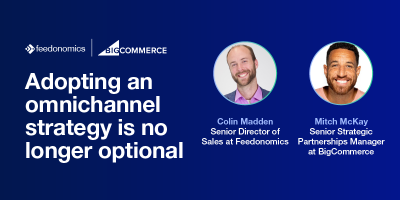Is your business a mighty oak tree or a thin green reed?
Confucius said, “The green reed which bends in the wind is stronger than the mighty oak which breaks in a storm.”
Translation—to thrive in ecommerce, you need to stay flexible.
Today, the winds of change are blowing toward omnichannel commerce, with interconnected systems, platforms, and channels that allow you to do more with your data.
With effective automation, you can collect, optimize, and transfer data across various touchpoints to reach more relevant customers, deepen the customer-brand relationship, and streamline your operations.
We highlighted the importance of quality data when we covered some of the key considerations for executing an omnichannel strategy, but how exactly does data feed management fit into omnichannel commerce as a whole?
What does a data feed management platform do?
A data feed management platform is the bridge between your product data source and the ad channels or marketplaces you want to list products on. This technology makes it easier to format your product catalog according to the requirements of each channel.
The best feed management platforms have direct integrations with hundreds of channels and help ensure that product, order, and inventory data are consistently updated.
Here’s how you can expect a quality data feed management platform to fit into your omnichannel commerce strategy.
Catalog Management and Product Listing Optimization
Product data is at the heart of your ecommerce presence, so it’s essential to keep your catalog updated, which includes:
- Removing old products and listing new ones
- Changing prices and synchronizing inventory quantities
- Adding missing or supplementary product attributes
With a data feed management platform, you can use a single source of data to create unique catalog exports for every channel and automatically update your product listings when data is refreshed. This makes scaling your business and adding new channels a simpler proposition.
Optimized product catalogs maximize the potential search relevancy of your product listings, allowing you to reach customers who are more likely to purchase.
Product listing optimization encompasses the following processes:
- Creating consistent product listings across all channels with clean titles, descriptions, bullet points, and more
- Inserting valuable keywords and product nouns into your titles
- Categorizing products accurately for each sales channel
- Grouping product variants together
- Filling in as many category-specific or channel-specific recommended attributes as possible
A feed management platform can be used to clean up your source data, optimize your listings to meet channel-specific requirements and best practices, and create brand consistency by maintaining a standard of quality wherever your products appear.
By providing product details that closely match what a consumer is looking for, you increase the likelihood that your listings appear in the search results for a shopper’s specific query.
Put another way, if somebody is searching for a “large men’s green zipper hoodie,” they’re probably close to making a purchase; if you have a product that fits the bill, you’d be rather disappointed when they don’t find your product in the search results.

Data feed management platforms can also be used to ensure accurate and granular channel-specific categorization to promote product discoverability. For example, if you’re listing motorcycle pants on Google Shopping, and you place that item in the “Motorcycle Protective Clothing,” category instead of the more specific “Motorcycle Pants,” category, then shoppers filtering for motorcycle pants might not see your product. Proper categorization increases the chances that your product is shown among the related items of another product page.
Marketplace Expansion
Expanding to a marketplace can increase your revenue by introducing your products to new customers. Nearly 45% of consumers begin their product research on marketplaces, but listing your product on top shopping destinations like Amazon, eBay, Walmart, and Target Plus doesn’t translate to immediate success.
That’s because selling on marketplaces isn’t as simple as it sounds.
If you list products in bulk or automate the catalog updates between your ecommerce platform and the marketplace, the ability to optimize your data may be limited without a feed management solution.
Businesses looking to sell products on multiple online marketplaces reduce development costs by connecting to a data feed management platform first. This enables their source data to be endlessly reconfigured and exported in a unique feed to any channel without requiring an additional integration every time.
“How do I get my data out to all these channels efficiently? It’s a hard problem and a lot of merchants solve this with IT or a lot of grunt work in spreadsheets, and there are tools out there like Feedonomics that can help you do this really efficiently.”
Advertising
You want to drive additional traffic to your website or storefront through product advertising, but it needs to be worth the effort, time, and cost. Effective online advertising is achievable with optimized campaigns, and for optimized campaigns, you need high-quality product data.
Shopping Ads
Unlike text ads, shopping ads do not allow you to bid on keywords for ad placement. Instead, the data in your product listings serve as the “keywords” that determine how relevant a search is.
Data feed management software allows you to connect your product catalog to an ad channel like Google Shopping, but you need more than technology to keep your products listed. Google is known to have stringent policies that often result in product ads being unlisted.
Policy violations or errors can be caused by issues on a merchant’s website, such as a missing return policy, mismatches between the website and the product ads (e.g. different sale prices) or simple syntax and formatting problems in the product data itself.
Without the in-house expertise to keep up with the latest advertising channel requirements and best practices, you may face an account suspension and lose a valuable marketing channel for your business. Our full-service feed management solutions include a team of channel experts to support you.
Local Inventory Ads (LIAs)
For businesses with a physical storefront, data feed management opens up more opportunities for local inventory ads. When users search for a product on either Google or Microsoft, a local inventory ad surfaces, informing the user that a local store nearby has inventory for that product. LIAs appear alongside online shopping ads, and users have the option to purchase the product online and pick it up from the local retailer.
Setting up LIAs requires an additional data feed that contains information such as store locations and updated product inventory by store.
LIAs give retailers the opportunity to drive more foot traffic at a moment when customers are actively searching for a product. They also let shoppers check out merchandise in person before buying.
Social Commerce
The way we buy and sell has evolved considerably over the last few years. One change can be seen in where we make our purchases. With the advance of native checkout and dynamic ad formats, social channels now double as shopping destinations that allow customers to go from “add to cart” to “place order” without interrupting their social media experience.
Paired with a smart user-generated content strategy, brands leverage these networks to tell their stories and find long-term advocates for their mission and products.
If social commerce is a part of your omnichannel strategy, a data feed management platform enables you to update and synchronize your marketplace catalog, shopping ads, and social media listings. This keeps your brand consistent, increases consumer trust, and helps ensure a positive experience on any channel (which takes pressure off your customer service team). You can also try cool things like retargeting or using lifestyle images as your main product photo.
“If I’m going to buy a set of five toothbrushes for my guest bathroom, I might go right to Amazon, but if I’m interested in buying some sustainable clothing for the winter, I might go shop around a little bit.
I might want to go read about the brands that I’m going to buy from, I might want to know where their clothes are made, or maybe I want to compare prices across a bunch of different retailers. Maybe I care about the mission, or I want to see the teams, or I want to see what new products some of my favorite brands have in store. I am not in just one place as a consumer and so, of course, it makes sense that retailers that are selling their products across more channels are just doing better, and it’s significant.”
Nailing your omnichannel strategy can be tough. Grab a copy of our free omnichannel guide!
Safeguards and Data Governance
One issue with integrated, automated systems is that inaccurate data can cause exponentially bigger problems.
For example, if your data indicates a product is in stock when it’s not, you’ll need to cancel any orders that were placed at the time of the mistake. This leads to a poor customer experience, negative reviews, and potentially an account suspension. The risk increases for companies with large product catalogs, where manual quality control is practically impossible.
Generally, some errors are inevitable, but many are prevented with proper feed management. A good feed management solution has safeguards to detect problems in your source data before they ever reach your ad channels or marketplaces. Solving problems at the source is the most efficient way of eliminating their recurrence.
Take this case study for example.
A leading industrial product provider in the UK encountered data-quality issues that were impacting revenue, and its existing feed management platform wasn’t equipped to resolve them.
The company was selling more than 700,000 stocked products and offered access to 3 million non-stocked products for a global customer base. With such a large catalog, it faced constant account warnings and account suspensions.
“When you talk about tens of thousands of pounds per day generated through Google Shopping, to have that [revenue] risk removed is crucial,” said Sam Dillon, the company’s Martech Manager.

Data governance systems can detect unexpected changes in source data or missing product attributes, and prevent a bad feed from overwriting existing listings. With its safeguards and alerts, Feedonomics helped the UK-based company clean up its data and get its Google Merchant Center account in good standing.
“The platform has enabled us to not just fix issues, but identify problems that we didn’t know we had,” Dillon said. “Issues that are way, way upstream in our data pools that we’ve been able to flag, get looked at, and have resolved before they even get to us.”
Feedonomics allows you to set safeguards that protect your data in a variety of ways:
- Stop exports or send alerts when we detect issues like incorrect data or missing key attributes (e.g. pricing or inventory)
- Prevent overselling and protect your seller rating with inventory buffers and channel allocation rules
- Monitor orders and send alerts to help your team action any potential issues
A/B Testing for Better Performance
Any business that rests on its laurels is eventually sunk by hungrier competitors. Empires that fail to innovate become stagnant, crumbling into the annals of history.
Sound depressing? Not to worry. If you’re dedicated to testing and optimizing your channel presence, then a data feed management platform can help stop your business from becoming obsolete.
A data feed management platform makes it easier to set up your product feed for A/B testing, so you can make data-driven decisions. With deliberate and methodical changes to the product data in your feeds, you can identify ways to improve the performance of your ads or sales.
Test changes in your titles, descriptions, and images, gain clarity about your brand recognition, and learn if certain product types respond to changes more positively than other product types. The ultimate goal is to yield better results on your product listings.
Data feed management platforms can categorize your products in a granular way and combine data from multiple sources into a single database. Having all of this data organized in one place gives you the ability to methodically transform your product listings with a high level of control.
Learn how we helped VIETRI A/B test different keywords and campaign types, which led to year-over-year increases in click-through rates (nearly 30%), conversion rates (80%), and return on ad spend (37%).
Order Management and Customer Service
If your ecommerce portfolio includes multiple marketplaces and sales channels, order management can be a tedious task. There is plenty of room for error when managing stock, communicating with customers, and fulfilling orders.
Streamlining everything is GOOD.
Order management and effective customer service are reliant on the efficient handling of data. The more quickly you process orders or identify stock-outs, the easier it is to keep your customers happy. Automated order management reduces manual work by regularly retrieving and inserting orders from marketplaces into your ecommerce platform for you.
The role that feeds management platforms play in data governance also benefits you in managing your orders. Your platform can alert you in the case of missing inventory from the source data, and apply inventory buffers to prevent you from overselling.
For example, if you have low inventory or fast-moving products, you might want to always keep three stock units on hand rather than report 100% of your inventory to Amazon. That way, if you receive a sudden influx of marketplace orders and website orders at the same time, you can fulfill them all without issue.
The Full-Service Data Feed Management Solution for Omnichannel Commerce
Feedonomics offers a full-service data feed management platform with teams dedicated to each part of the feed build process: onboarding, integration, channel exports, error monitoring, and quality assurance.
We have channel specialists who optimize your feeds to suit your chosen channels, helping you with your evolving channel expansion strategy.
“We are actually one of the only omnichannel providers in the entire world [whose] modus operandi is a managed service. So, that means we use our technology to build and manage feeds on behalf of our customers.
Even for folks who were using specific omnichannel tools, we’re still saving [them] almost a full workweek every month. That’s really significant, even if you just wanted to put it in cold hard cash terms; 40 hours from a high-level BI analyst or an I.T. person is really significant.”

With its leading data feed management platform, Feedonomics helps brands, retailers, and agencies optimize and list products on hundreds of shopping destinations around the world. Learn more about our full-service solutions for advertising channels and marketplaces.




